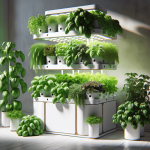This post may contain affiliate links. As an Amazon Associate, we may earn commissions from qualifying purchases.
Ever found yourself asking, “What are the most effective ways to prevent plant diseases naturally?” It’s a question that can keep any gardening enthusiast up at night, fretting over wilting leaves or sudden spots and wondering what you can do to keep your plants healthy without resorting to harsh chemicals. Fear not; you’re not alone in this journey, and there’s a bounty of natural methods you can employ to keep your green friends flourishing.
Understanding Plant Diseases
What Are Plant Diseases?
Let’s start with the basics. A plant disease can be anything that adversely affects the growth, function, or appearance of a plant. Just as we can catch colds or flu, plants can succumb to a variety of illnesses. Bacteria, fungi, viruses, and even nematodes can be culprits.
Symptoms to Watch For
To prevent plant diseases effectively, first, you ought to recognize the symptoms. Some common signs are:
- Leaf Spots: Brown, black, or yellow spots on leaves.
- Wilting: Drooping or collapsing of plant parts.
- Mildew: White or gray powdery growth.
- Blights: Rapid and extensive browning, often affecting leaves and stems.
Why Go Natural?
Sure, chemical solutions are out there, promising swift results. But natural methods offer various advantages, like being eco-friendly, maintaining soil health, and safeguarding beneficial insects. Plus, let’s be honest, there’s a certain satisfaction in knowing you’re working harmoniously with nature.
Choosing Resistant Varieties
Sometimes the best defense is a good offense, and that starts with picking the right kind of plants.
What Are Resistant Varieties?
These are plant breeds specifically developed to resist certain diseases. While no plant is completely immune to all illnesses, resistant varieties are much less likely to succumb to specific issues.
Benefits of Resistant Varieties
- Reduced Need for Pesticides: Natural resistance means fewer chemicals.
- Healthier Plants: Plants that are naturally resistant tend to be hardier in general.
- Increased Yields: Less disease often means more flowers, fruits, and veggies.
Examples of Resistant Plants
- Tomatoes: Varieties like ‘Celebrity’ and ‘Better Boy’ are resistant to numerous diseases.
- Roses: Look for hybrids labeled as disease-resistant.
- Squash: ‘Success PM’ is resistant to powdery mildew.

Proper Spacing and Crop Rotation
Now that you’ve chosen the best plants, think about how and where you’re planting them.
How Spacing Helps
Overcrowded plants are more likely to develop diseases because poor air circulation fosters a damp environment, perfect for fungi and bacteria to thrive.
Recommended Spacing:
| Plant Type | Recommended Distance |
|---|---|
| Tomatoes | 24-36 inches |
| Cucumbers | 12-18 inches |
| Lettuce | 12 inches |
| Beans | 3-4 inches |
What Is Crop Rotation?
Crop rotation means changing the type of plants you grow in a particular area each season. This breaks the life cycle of pests and diseases, making it harder for them to take hold.
How to Plan Crop Rotation
- Staple Crops: Group plants into families (e.g., nightshades, legumes).
- Rotate Annually: Change planting locations every year.
- Cover Crops: Use cover crops to enrich the soil and break pest cycles.
Soil Health and Composting
Healthy soil is the foundation of healthy plants. Naturally, enriching your soil can significantly decrease the risk of disease.
Importance of Soil Health
Good soil structure, rich in organic matter, provides plants with nutrients and improves their overall immunity.
Composting Basics
Composting is an excellent way to improve soil health without chemicals.
Composting Steps:
- Collect: Gather kitchen scraps, yard waste, and other organic materials.
- Balance: Maintain a balance of greens (like vegetable peels) and browns (like dried leaves).
- Aerate: Turn the pile periodically to provide air.
Benefits of Compost
- Nutrient-Rich: Adds vital nutrients to the soil.
- Enhances Texture: Improves soil structure.
- Beneficial Microbes: Introduces microlife that aids in plant health.

Watering Techniques
How and when you water can make all the difference in preventing plant diseases.
Best Watering Practices
- Morning Watering: Always water in the morning. This allows foliage to dry throughout the day, reducing the risk of fungal growth.
- Soaker Hoses: These deliver water directly to the soil, keeping leaves dry.
The Role of Mulching
Mulch isn’t just for aesthetics. It’s your ally in disease prevention.
Mulching Benefits:
- Moisture Retention: Helps soil retain moisture.
- Temperature Control: Keeps the soil cooler in summer and warmer in winter.
- Weed Suppression: Reduces weeds that can harbor diseases.
Natural Pesticides and Beneficial Insects
Sometimes, even with the best care, pests still find their way into your garden. Here’s what you can do naturally.
Natural Pesticides
Homemade Remedies:
| Ingredient | Recipe | Application |
|---|---|---|
| Neem Oil | Mix 2 tablespoons with a gallon of water | Spray weekly to deter insects and fungi |
| Garlic Spray | Blend cloves with water; strain | Use for repelling insects |
| Baking Soda | 1 tablespoon with a gallon of water | Use to combat powdery mildew |
Beneficial Insects
Invite the right kind of bugs to your garden.
Types of Beneficial Insects:
- Ladybugs: They feast on aphids.
- Praying Mantises: Known for eating various harmful insects.
- Bees: Pollinators that aid in healthy plant growth.
How to Attract Beneficial Insects
- Plant Diversity: Grow a variety of plants to attract various beneficial insects.
- Provide Water: A small water source can attract helpful bugs.
- Avoid Pesticides: Broad-spectrum pesticides can harm these beneficial creatures.
Hygiene and Garden Maintenance
Keeping your garden clean and well-maintained can act as a powerful deterrent against diseases.
Why Garden Hygiene Matters
Regular cleaning and maintenance can eliminate potential hiding spots for pests and disease vectors.
Cleaning Tools
Best Practices:
- Sanitize: Periodically clean your gardening tools with a solution of 1 part bleach to 9 parts water.
- Inspect: Look for and remove damaged or diseased plant parts.
- Clear Debris: Regularly clear fallen leaves and other plant debris.
Pruning Appropriately
Proper pruning encourages better air circulation and removes potential sources of infection.
Pruning Tips:
- Timing: Prune during dry weather.
- Tools: Use sharp, sanitized tools.
- Technique: Cut at an angle to prevent water from accumulating on the cut surface.
Companion Planting
Ever heard of plants being best buddies? Companion planting can be your garden’s secret weapon.
What Is Companion Planting?
This practice involves growing certain plants together to improve growth and deter pests.
Effective Companion Planting Combinations
| Plant | Companion | Benefit |
|---|---|---|
| Tomatoes | Basil | Repels tomato hornworms |
| Carrots | Onions | Deterrent for carrot flies |
| Cucumbers | Radishes | Radishes repel cucumber beetles |
Benefits of Companion Planting
- Natural Deterrence: Some plants naturally deter specific pests.
- Increased Yield: Improved pollination and reduced competition.
- Nutrient Utilization: Different plants use soil nutrients more efficiently.
Using Cover Crops and Green Manures
What if you could enhance your soil health while controlling diseases between your growing seasons?
What Are Cover Crops?
These are plants grown primarily to benefit the soil rather than for harvest.
Types of Cover Crops
| Type | Example | Benefit |
|---|---|---|
| Legumes | Clover | Nitrogen fixation |
| Grasses | Rye | Weed suppression and soil improvement |
| Brassicas | Mustard | Biofumigation to reduce soil pathogens |
How to Use Cover Crops
- Choose: Select the appropriate cover crop for your needs.
- Plant: Sow the seeds after harvesting your main crops.
- Terminate: Cut down or till the cover crop into the soil before planting the next round of crops.
Monitoring and Quick Response
Even with all these preventive measures, vigilance is crucial. Monitoring allows you to catch issues before they escalate.
Regular Inspections
Make a habit of inspecting your garden frequently.
What to Look For:
- Leaf Discoloration: Early indicator of nutrient deficiencies or disease.
- Sudden Wilting: Could signal pests or root issues.
- Unusual Spots: Often the first sign of fungal infections.
Immediate Action
When you spot a potential problem, act quickly.
- Isolate: Remove affected plants or plant parts to prevent the spread.
- Diagnose: Identify the issue to determine the best treatment.
- Treat: Use natural remedies based on your diagnosis.
Educating Yourself
Knowledge is power and the more you know, the better you can care for your garden.
Continuous Learning
New information and techniques are continuously being discovered.
Ways to Stay Updated:
- Books and Journals: Subscribe to gardening journals or pick up well-reviewed books.
- Workshops: Attend gardening workshops or local community garden events.
- Online Resources: Follow credible agricultural websites and online forums.
Networking with Fellow Gardeners
Connecting with others can be invaluable.
Benefits of Networking:
- Shared Knowledge: Learn from others’ experiences and successes.
- Support System: Gain encouragement during challenging gardening times.
- Community: Sometimes, it’s just nice to share your gardening joys and woes with like-minded individuals.
Conclusion
Taking steps to prevent plant diseases naturally involves a series of thoughtful practices and strategies. From choosing resistant plant varieties to embracing proper hygiene, every little effort goes a long way in preserving the health and beauty of your garden. By being observant, proactive, and embracing natural methods, you can cultivate a garden that’s both bountiful and in harmony with nature. So, go ahead, put these tips into action and watch your garden flourish like never before.







